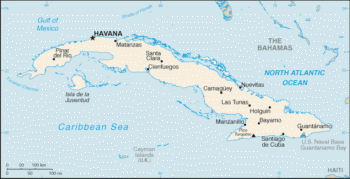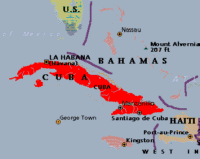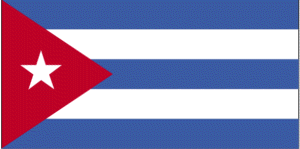| Republic of Cuba República de Cuba

Location Caribbean Sea

Area 44,218 sq mi
(114,524 sq km)
Greatest Distance NW-SE 759 mi (1,221
km)
Greatest Distance N-S 135 mi (217 km)
Coastline 2,100 mi (3,380 km)
Highest Point Pico Turquino; 6,542 ft
(1,994 m)
Lowest Point Caribbean Sea; sea level
Natural Resources cobalt, nickel, iron
ore, chromium, copper, salt, timber, silica, petroleum,
arable land
Nationality Cuban
Population (May 2013 est) 11,061,886
Largest Cities Havana
Ethnic Groups white, mulatto and
mestizo, black
Religions Roman Catholic, Protestant
Languages Spanish
Capital Havana
Form of Government communist
Present Constitution Adopted February
24, 1976
Chief of State and Head of Government President
of the Council of State Raul Castro Ruz (since February
24, 2008)
Cabinet Council of Ministers
Legislature unicameral National Assembly of
People's Power (Asemblea Nacional del Poder Popular)
Judiciary People's Supreme Court (Tribunal
Supremo Popular)
Local Administration 14 provinces and 1 special
municipality
Currency Peso
Per Capita Income $10,200
Principal Industries sugar, petroleum,
tobacco, construction, nickel, steel, cement,
agricultural machinery, pharmaceuticals
Agricultural Products suar, tobacco, citrus,
coffee, rice, potatoes, beans; livestock
Export Commodities sugar, nickel,
tobacco, fish, medical products, citrus, coffee
Import Commodities petroleum, food,
machinery and equipment, chemicals
Independence Achieved
December 10, 1898
From Spain
National Holiday Triumph of the
Revolution; January 1 (1959)
Flag the blue bands refer to the
three old divisions of the island -- central, occidental,
and oriental; the white bands describe the purity of the
independence ideal; the triangle symbolizes liberty,
equality, and fraternity; the red color stands for the
blood shed in the independence struggle; the white star,
called La Estrella Solitaria (the Lone Star) lights the
way to freedom and was taken from the flag of Texas

Questions or comments about this
page?
|
 SKC Films Library
SKC Films Library

